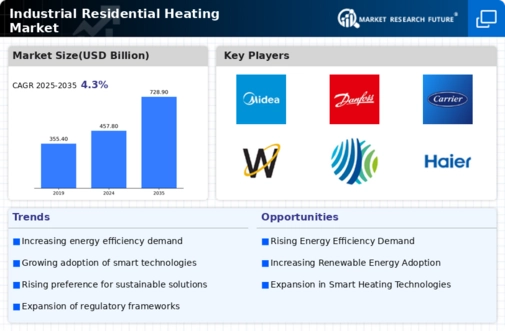Market Growth Projections
The Global Industrial Residential Heating Market Industry is projected to experience substantial growth over the coming years. With a market value of 457.8 USD Billion in 2024, it is anticipated to reach 728.9 USD Billion by 2035. This growth trajectory suggests a compound annual growth rate (CAGR) of 4.32% from 2025 to 2035. Such projections reflect the increasing demand for efficient and sustainable heating solutions, driven by technological advancements, regulatory changes, and shifting consumer preferences. The market's expansion is indicative of a broader trend towards modernization and sustainability in residential heating.
Rising Energy Efficiency Standards
The Global Industrial Residential Heating Market Industry is experiencing a notable shift towards energy efficiency, driven by stringent regulations and standards set by governments worldwide. These regulations aim to reduce energy consumption and greenhouse gas emissions, compelling manufacturers to innovate and develop more efficient heating solutions. For instance, the introduction of energy efficiency labels has encouraged consumers to opt for high-efficiency heating systems. As a result, the market is projected to reach 457.8 USD Billion in 2024, reflecting a growing demand for sustainable heating technologies that comply with these standards.
Urbanization and Population Growth
Urbanization and population growth are significant factors influencing the Global Industrial Residential Heating Market Industry. As more individuals migrate to urban areas, the demand for residential heating solutions escalates. This trend is particularly evident in developing countries, where rapid urbanization leads to increased construction of residential buildings. Consequently, the need for efficient and reliable heating systems becomes paramount. The market is expected to benefit from this demographic shift, as more households seek modern heating solutions to accommodate their growing needs, further driving the industry's expansion.
Growing Demand for Renewable Energy Sources
The Global Industrial Residential Heating Market Industry is witnessing a surge in demand for renewable energy sources, driven by increasing environmental awareness and government incentives. Consumers are increasingly seeking heating solutions that utilize renewable energy, such as solar thermal systems and biomass boilers. This shift is supported by various government initiatives aimed at promoting sustainable energy practices. As a result, the market is likely to expand as more households transition to renewable heating solutions, aligning with global efforts to reduce carbon footprints and enhance energy independence.
Technological Advancements in Heating Systems
Technological advancements play a crucial role in shaping the Global Industrial Residential Heating Market Industry. Innovations such as smart thermostats, advanced heat pumps, and integrated heating solutions enhance user experience and energy management. These technologies not only improve efficiency but also provide users with greater control over their heating systems. The integration of IoT in heating solutions allows for remote monitoring and optimization, which is increasingly appealing to consumers. As these technologies continue to evolve, they are expected to contribute significantly to the market's growth, with projections indicating a rise to 728.9 USD Billion by 2035.
Increased Investment in Infrastructure Development
Increased investment in infrastructure development is a key driver of the Global Industrial Residential Heating Market Industry. Governments and private sectors are allocating substantial resources to enhance residential infrastructure, including heating systems. This investment is particularly pronounced in emerging economies, where the demand for modern heating solutions is on the rise. Improved infrastructure not only facilitates the installation of advanced heating systems but also promotes energy-efficient practices. As a result, the market is poised for growth, with a projected CAGR of 4.32% from 2025 to 2035, indicating a robust trajectory for the industry.






















Leave a Comment